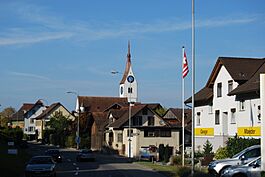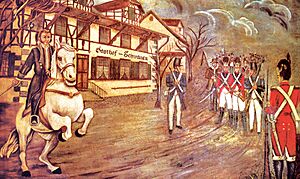Merenschwand facts for kids
Quick facts for kids
Merenschwand
|
||
|---|---|---|
 |
||
|
||
| Country | Switzerland | |
| Canton | Aargau | |
| District | Muri | |
| Area | ||
| • Total | 13.51 km2 (5.22 sq mi) | |
| Elevation | 396 m (1,299 ft) | |
| Population
(Dec 2020 )
|
||
| • Total | 3,712 | |
| • Density | 274.76/km2 (711.6/sq mi) | |
| Postal code |
5634
|
|
| Surrounded by | Aristau, Benzenschwil, Hünenberg (ZG), Mühlau, Muri, Obfelden (ZH), Ottenbach (ZH) | |
Merenschwand is a small town, also called a municipality, in Switzerland. It's located in the Muri district, which is part of the canton (like a state) of Aargau. On January 1, 2012, the nearby town of Benzenschwil joined with Merenschwand. The current mayor is Selina Schär.
Contents
History of Merenschwand
The very first signs of people living here date back to the Late Bronze Age. This was a time when people used bronze tools. They lived in a village by a lake. That lake is now a meadow called Rütiweid.
The name Merenschwand first appeared in the 12th century as Meriswanden. Later, in 1263, it was called Meriswandon. There might have been a knightly family and a castle nearby, but we don't have clear proof.
Merenschwand was ruled by the Homberg family until 1293. After that, the Lords of Hünenberg and Schär took over. In 1393, Merenschwand bought its freedom with money borrowed from Lucerne. Many people from the village had become citizens of Lucerne. So, in 1394, Merenschwand officially became part of Lucerne.
This made Merenschwand the center of a bailiwick, which was an area ruled by a special officer called a vogt. The people of Merenschwand got to choose their own vogt from important families in Lucerne. In 1810 and 1813, the towns of Mühlau and Benzenschwil joined this bailiwick. Until 1798, Merenschwand managed its own affairs quite well under a local bailiff. The gasthof (a hotel and restaurant) called Zum Schwanen was used as a court and a community meeting place.
In 1802, Merenschwand was briefly part of the Canton of Zug. Then, in 1803, it became part of the Canton of Aargau. In 1830, the innkeeper of Zum Schwanen, Johann Heinrich Fischer, led about 6,000 men in an event called the Freiämtersturm. They marched to Aarau and made the government agree to a new, more democratic constitution (a set of rules for how the government works).
The village church, St. Vitus, was first mentioned in 1245. It started as a family church for the Homberg and Hünenberg families. Later, it became the main parish church (a church serving a specific area) for the district. The church you see today was built between 1897 and 1899. It still has parts of the old Gothic style. Benzenschwil is still part of this church's parish, but Mühlau is now part of the Sins parish.
In the 19th and 20th centuries, many people in Merenschwand earned money by making straw plaiting (braiding straw) at home. This straw was used by trading companies in Wohlen. They also wove silk for business people in Zurich. In the late 1900s, Merenschwand became a "bedroom community." This means many people who work in bigger cities like Zurich and Zug live here. This led to a lot of new buildings being built.
Geography of Merenschwand
Merenschwand is located in the Muri district, near the Reuss river valley. It includes the main village of Merenschwand, which is a haufendorf (an unplanned village with closely packed buildings). It also has smaller villages, called hamlets, like Unterrüti, Rickenbach, and Hagnau.
As of 2009, Merenschwand covered about 11.05 square kilometers (4.27 square miles). Most of this land, about 68.3%, is used for farming. About 11.4% is covered by forests. Buildings and roads make up about 11.3% of the land. Rivers and lakes cover about 4.5%, and 5.2% is land that can't be used for anything. After Benzenschwil joined in 2012, the total area of Merenschwand became larger.
Merenschwand's Coat of Arms
The blazon (a special description) of Merenschwand's coat of arms says: Azure a Swan proper standing of a Mount Vert and two Bulrush issuant. This means it shows a swan on a green hill with two tall plants. The swan (Schwan in German) is a clever way to include part of the town's name, which is called canting arms.
People in Merenschwand
As of 2014, Merenschwand has a population of 3,406 people. In June 2009, about 16% of the people living here were from other countries. Over ten years (1997–2007), the population grew by 27.8%.
Most people in Merenschwand (about 90.4%) speak German. The next most common languages are Albanian (4.6%) and Serbo-Croatian (1.9%).
In 2008, about 11.9% of the population were children aged 0-9 years old. Teenagers aged 10-19 made up 16%. Adults aged 20-59 made up about 55.7% of the population. Older adults (60 and above) made up about 16.4%.
In 2000, about 56.3% of the homes were owned by the people living in them. In 2008, there were 416 single-family homes in Merenschwand. There were also 13 empty apartments, meaning a 1.4% vacancy rate.
Important Buildings
The Gasthof (hotel and restaurant) Zum Schwanen and the Catholic parish church of Merenschwand are very important. They are listed as Swiss heritage sites of national significance. This means they are protected because of their historical and cultural value. The entire village of Merenschwand is also recognized as an important heritage site.
Economy and Jobs
In 2007, Merenschwand had a low unemployment rate of 1.56%. This means most people who wanted to work had jobs.
In 2005, there were 125 people working in the primary economic sector. This includes jobs like farming and forestry. There were 37 businesses in this sector. The secondary sector employed 624 people in 47 businesses. This includes jobs like manufacturing and construction. The tertiary sector had 280 people working in 59 businesses. This includes jobs like services, retail, and healthcare.
In 2000, 1,134 workers lived in Merenschwand. About 68.3% of them worked outside the town. However, 481 people came into Merenschwand for work. About 11.5% of workers used public transportation, and 54.5% used a private car to get to work.
Religion
Based on the 2000 census, about 61.8% of the people in Merenschwand were Roman Catholic. About 19.2% belonged to the Swiss Reformed Church.
Education
In Merenschwand, about 76.5% of adults (aged 25-64) have finished either higher secondary education (like high school) or even more education, such as university or a specialized college (called a Fachhochschule).
In the 2008/2009 school year, there were 263 students in primary school and 219 students in secondary school in Merenschwand. The town also has the Schul-u.Gde.Bibliothek Merenschwand, which is a library for both the school and the community.
Images for kids
See also
 In Spanish: Merenschwand para niños
In Spanish: Merenschwand para niños









